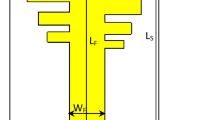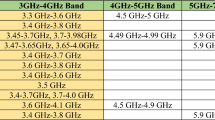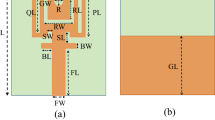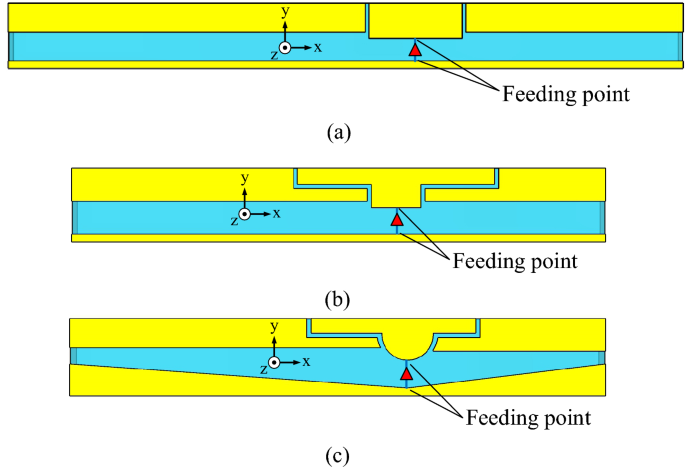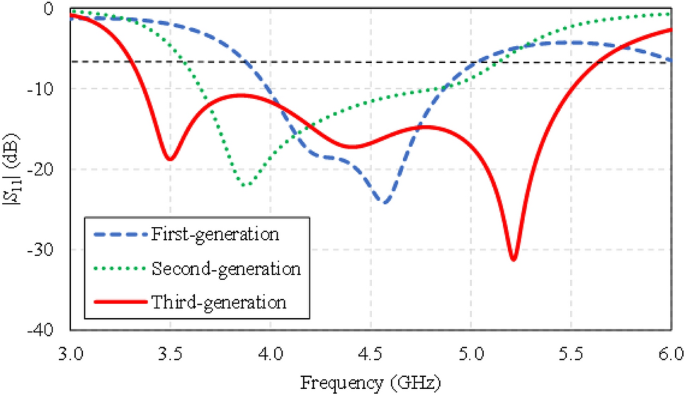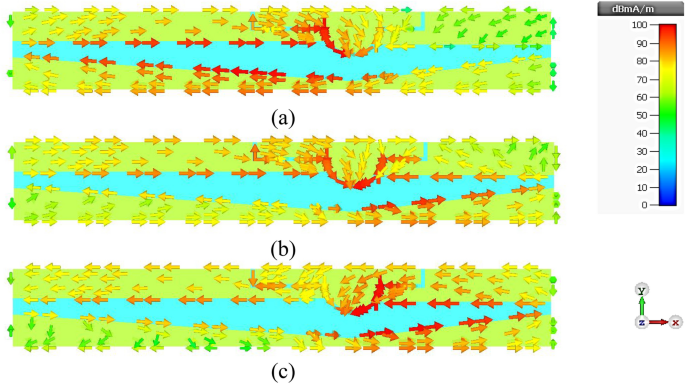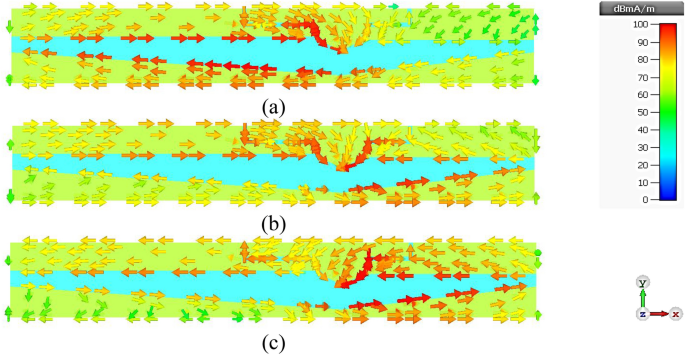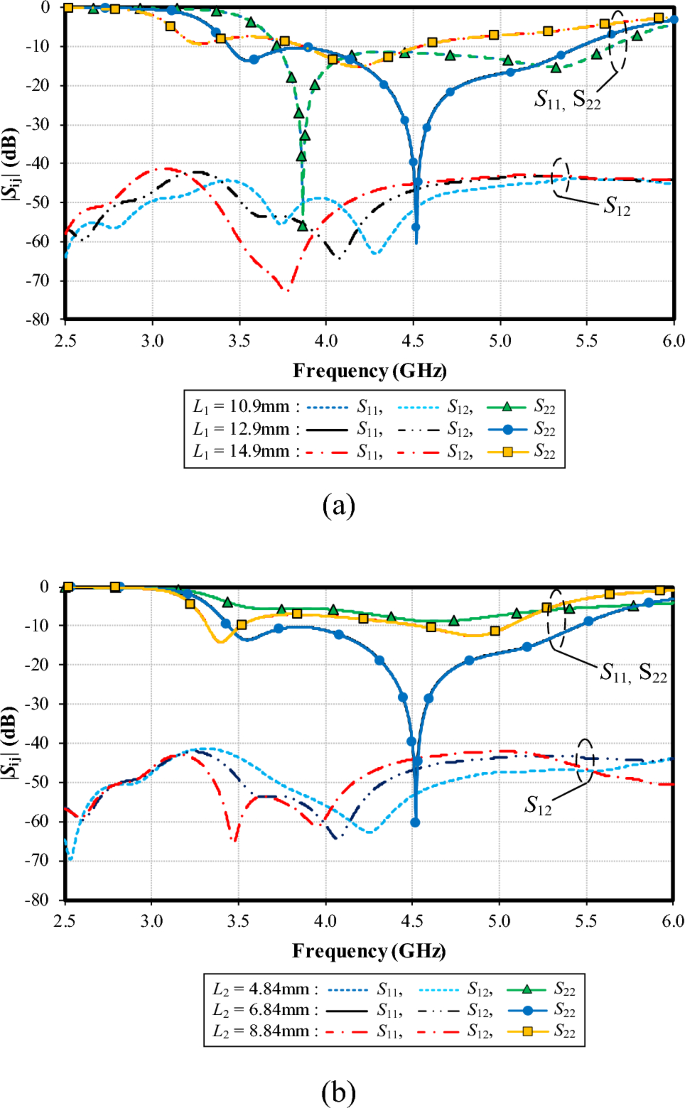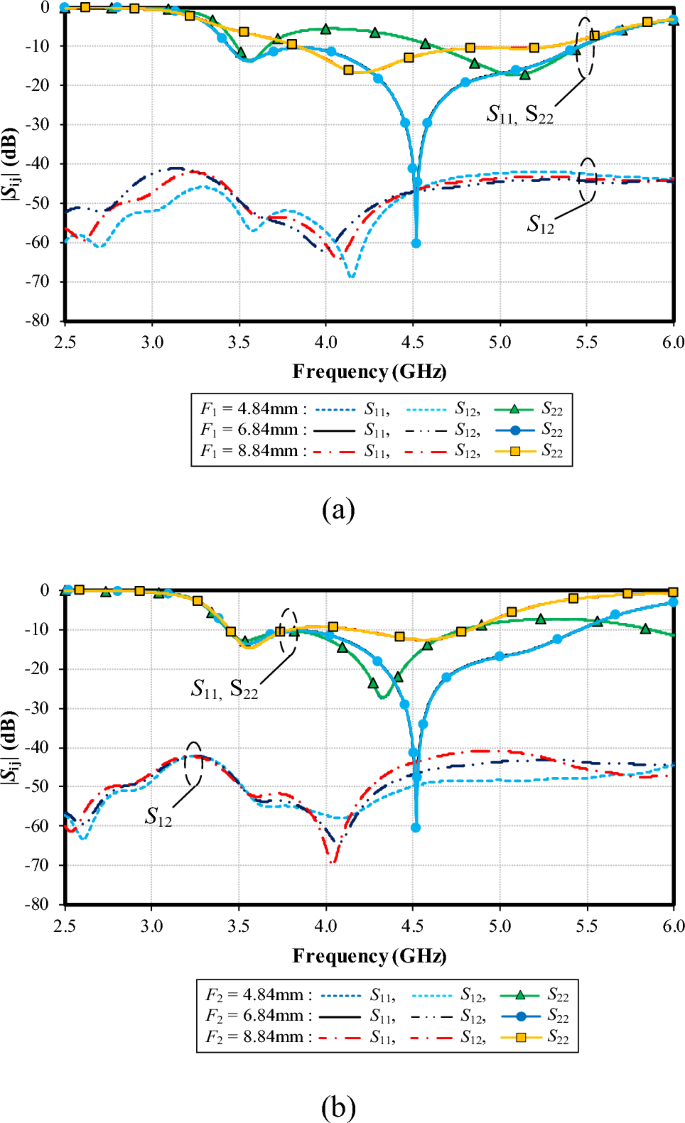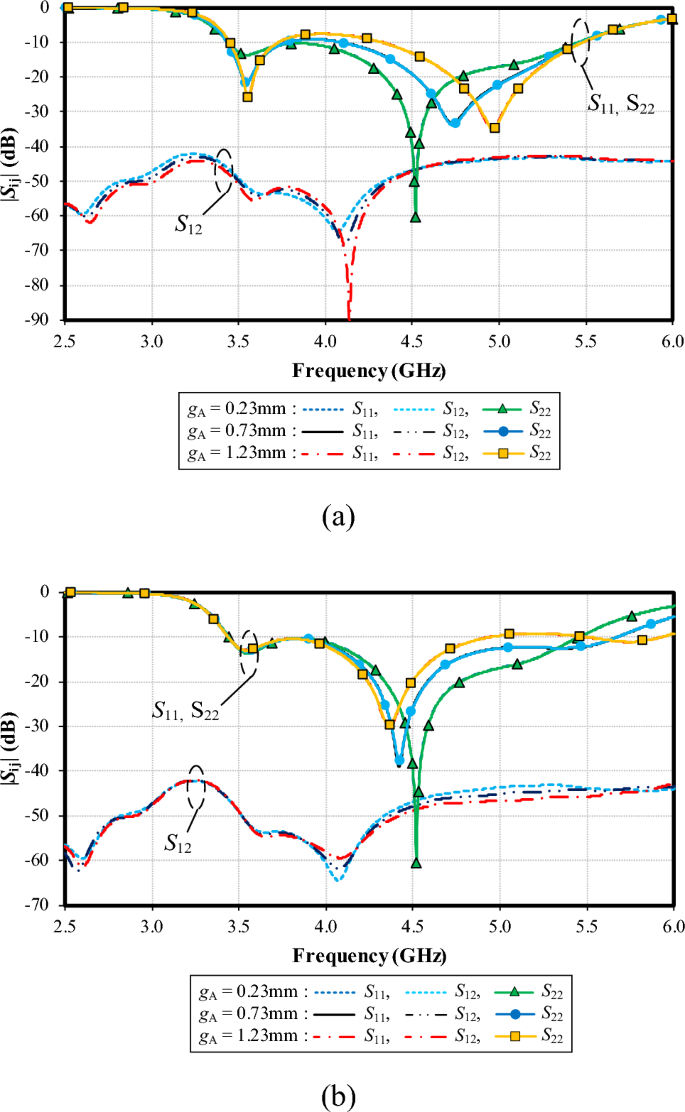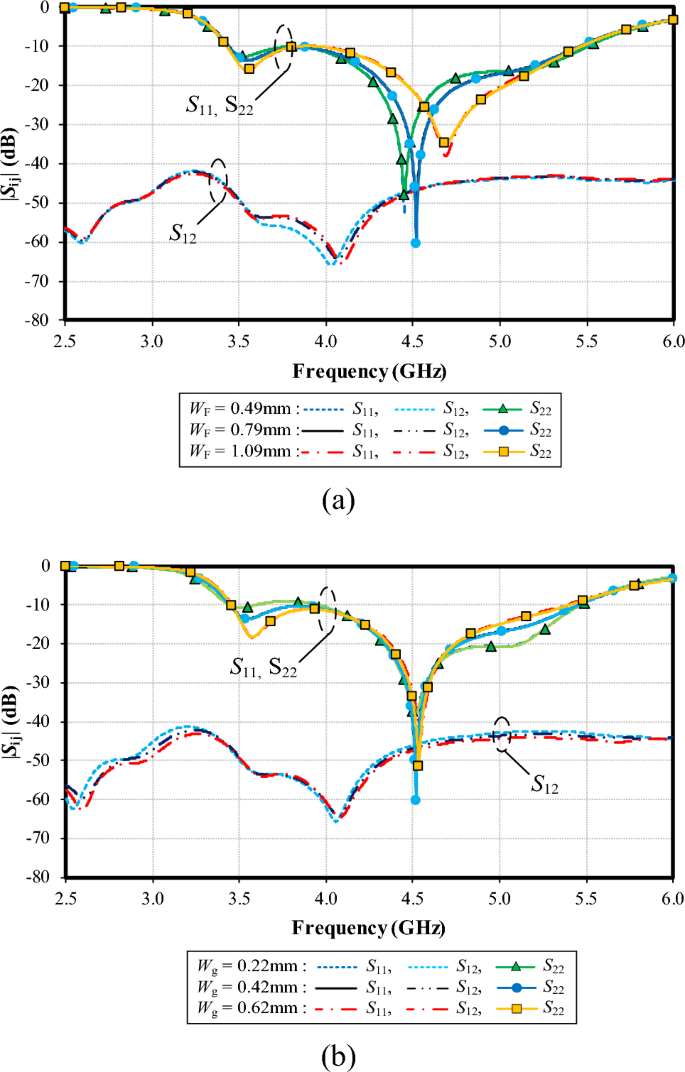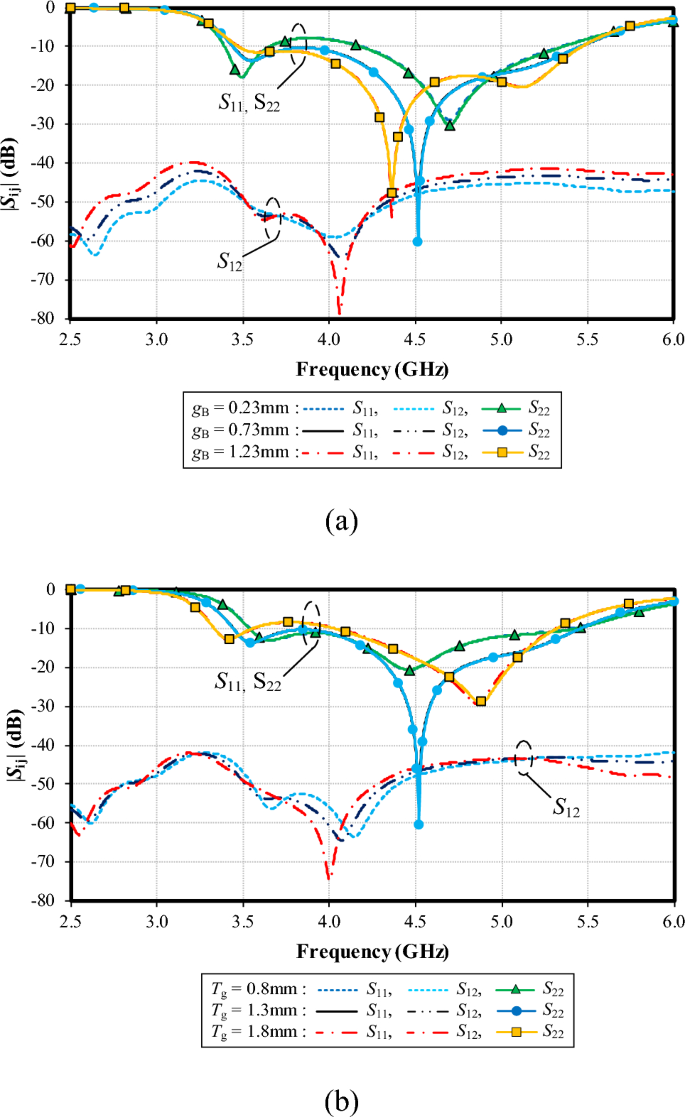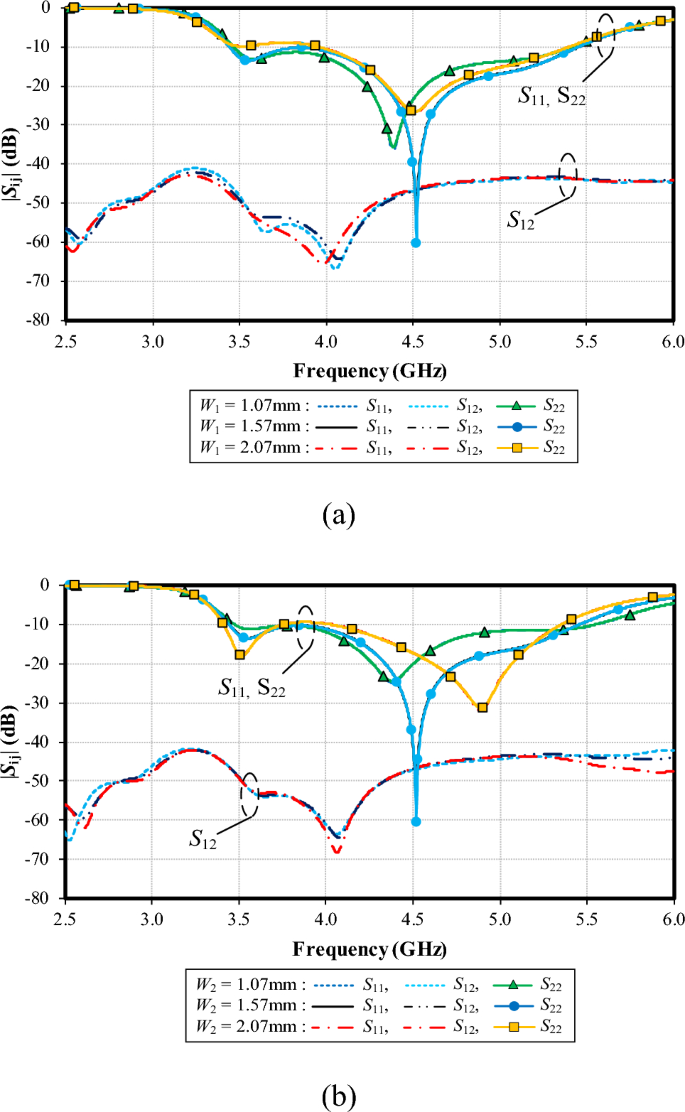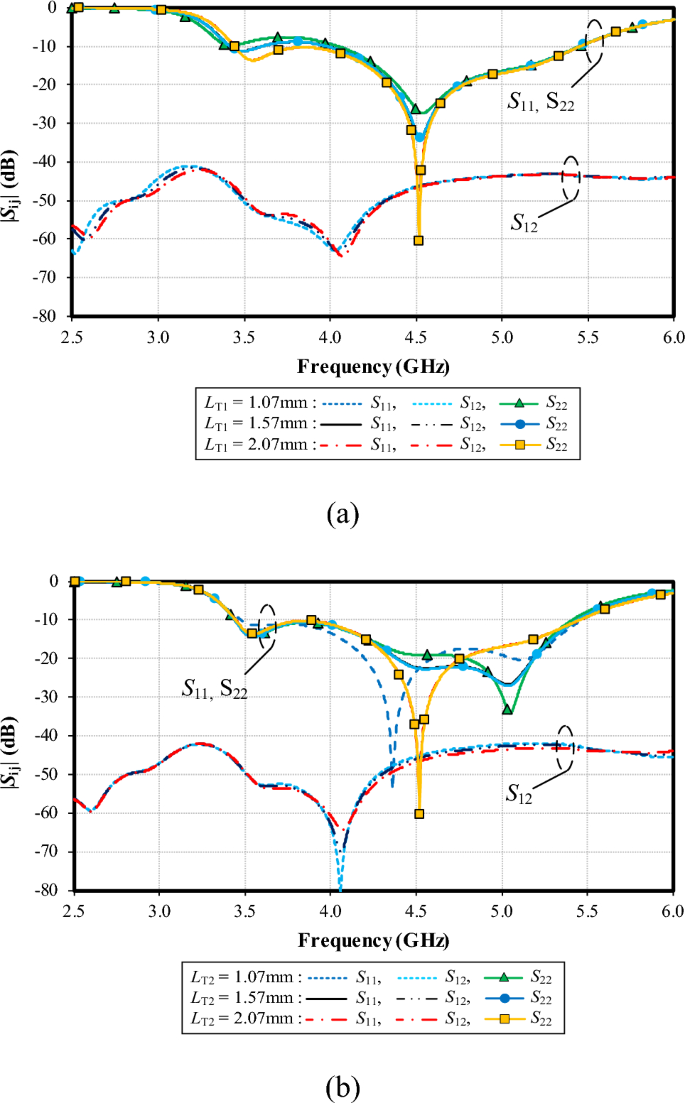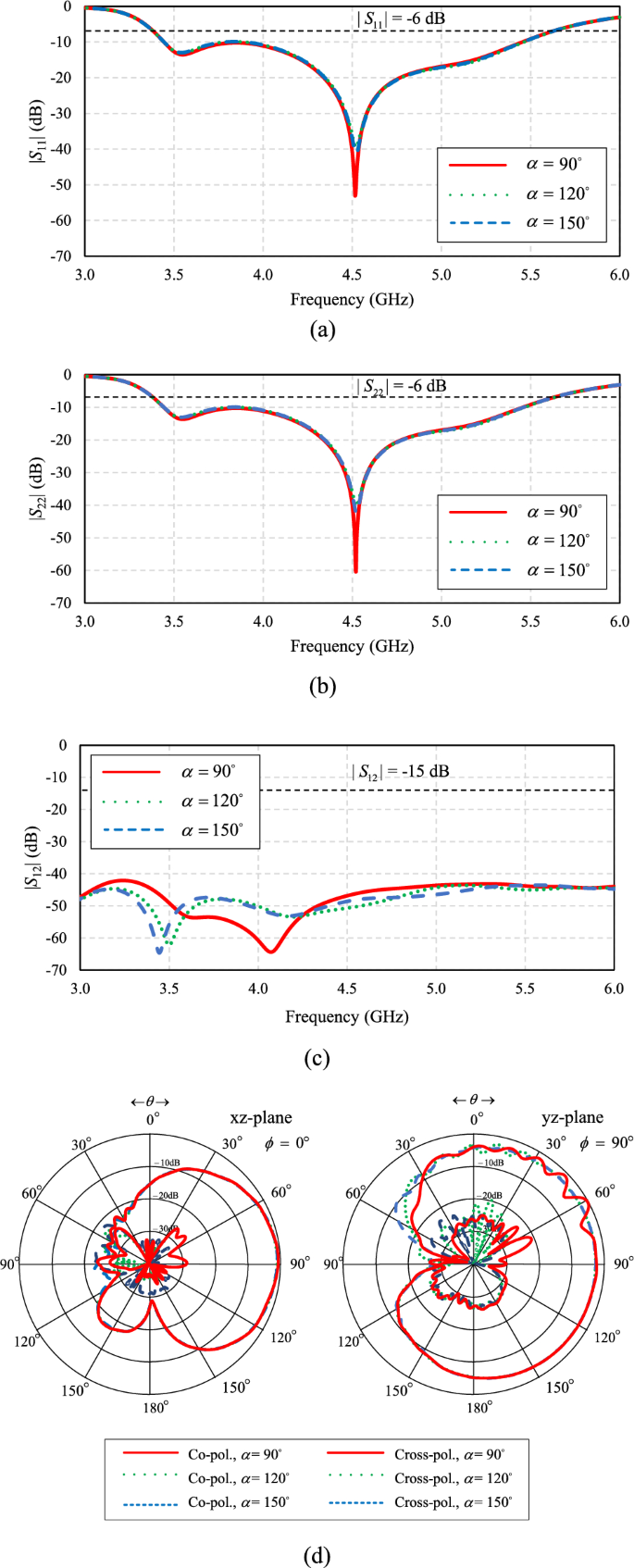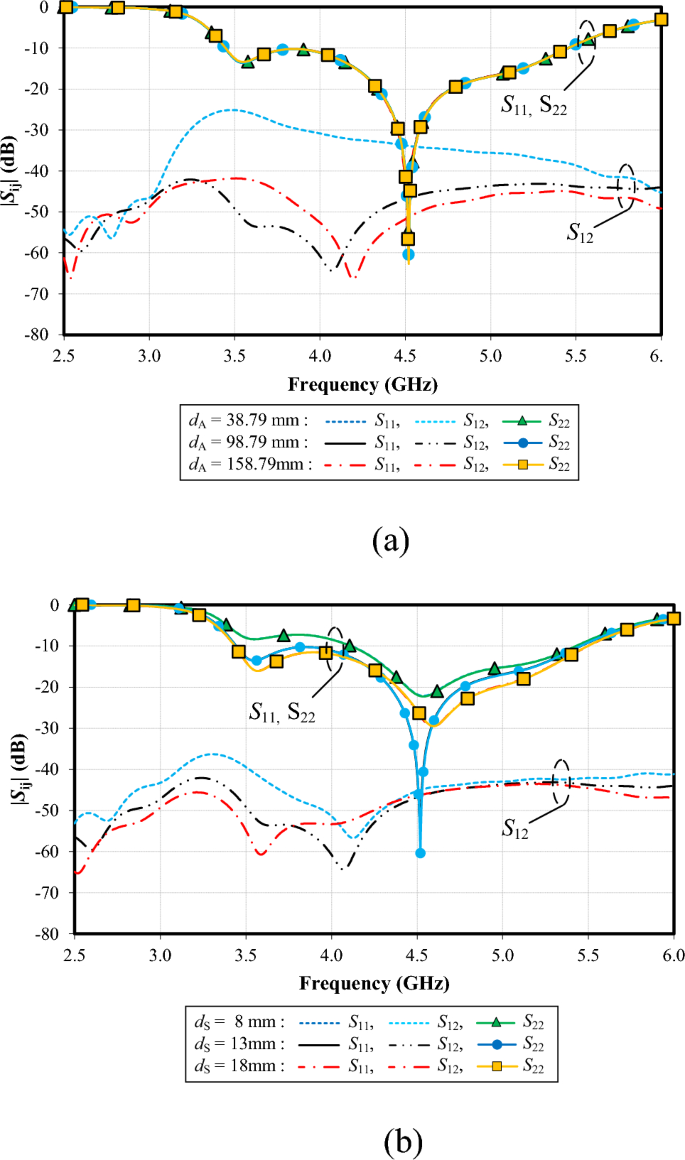Abstract
This research proposes a broadband unidirectional twin-element multiple-input-multiple-output (MIMO) antenna scheme for mid-band 5G and WLAN applications. The twin-element antenna scheme comprises two single-element antennas, and each single-element antenna consists of a T-shaped hemispherical feeding patch, left- and right-arm radiating patches, and a conjoined triangular ground plane. The twin-element MIMO antenna scheme is integrated with a laptop model functioning as the reflector. The measured impedance bandwidth (|S11|, |S22|≤ − 6 dB) are 55.32%, covering 3.4–6.0 GHz, and the measured mutual coupling (|S12|) is less than − 15 dB. The measured gain at the center frequency (4.5 GHz) is 4.585 dBi. Besides, the measured xz- and yz-plane cross-polarization levels are below − 25 dB and − 15 dB, respectively. The half-power beamwidth (HPBW) in the xz-plane at 3.5, 4.5, and 5.5 GHz are 99°, 92.8°, and 84.2°, and the corresponding HPBW in the yz-plane are 102°, 78°, and 102°. The measured xz- and yz-plane back lobe levels are below − 15 dB across the entire operating frequency band (3.5–5.5 GHz). The radiation pattern of the twin-element MIMO antenna scheme is of unidirectionality. Furthermore, the envelope correlation coefficient and diversity gain of the twin-element antenna scheme are < 0.001 and > 9.99 dB, respectively. The proposed broadband unidirectional twin-element MIMO antenna scheme is thus operationally suitable for mid-band 5G/WLAN communication systems. Essentially, this research is the first to propose a broadband twin-element MIMO antenna scheme for mid-band 5G/WLAN applications.
Similar content being viewed by others
Introduction
The fifth generation (5G) of wireless cellular technology offers faster data rates, lower latency, more reliable connections and capacity than previous cellular generations1,2,3. As a result, the 5G technology is ideal for applications that require fast and real-time data transmission4,5,6,7.
MIMO (multiple input, multiple output) is an antenna technology for wireless communications in which multiple antennas are used at both the source (transmitter) and the destination (receiver). MIMO antennas achieve faster data speed and higher transmission capacity as data can travel over many signal paths at the same time. The MIMO antennas can overcome interference, multipath fading, and radiation losses. The MIMO technology is thus essential for 5G applications to achieve low latency, maximum throughput, and high efficiency.
Different MIMO antennas for 5G mobile terminals were proposed to improve impedance bandwidth, reduce mutual coupling, and enhance isolation. In8, a three-slot printed wideband antenna operable in GSM and LTE bands achieved high antenna efficiency, bandwidth, and channel capacity. In9, an eight-element antenna with neutralization lines and ground slots also achieved high efficiency, bandwidth, channel capacity, and compact size.
In10, a self-adaptive MIMO antenna could achieve good decoupling and impedance matching, and a technique for decoupling inverted-F antennas (IFAs) by utilizing high-order ground plane modes has been proposed for a 5G mobile MIMO platform operating at 3.5 GHz11. In12, an eight-element uniplanar MIMO antenna with polarization diversity could reduce mutual coupling and improve interference and fading resistance. Besides, a four-element multi-band antenna with the common ground plane was proposed in13; and a multi-element antenna with balanced slot mode and polarization diversity was presented in14.
To improve data throughput and radiation efficiency of MIMO antennas, monopolar patch antennas (MPA) with monopole radiation patterns were deployed as element antennas in the antenna schemes15,16,17,18,19,20. In21, a Y-type MPA could achieve an antenna efficiency of 88% and envelope correlation coefficient (ECC) of 0.1, rendering it suitable for 5G access points. A four-port MIMO antenna was used in underlay and interweave cognitive radio22, and a wide-band MIMO antenna with frequency tuning was proposed in23.
In addition, neutralization lines24,25 and decoupling techniques26,27 were employed to improve isolation. In28, a pair of compact self-decoupled antennas with two antenna elements on the common ground plane could achieve good isolation, low ECC, and high antenna efficiency. In29,30,31,32, polarization diversity and F-shaped stubs were used in MIMO antennas to achieve high isolation and low ECC. Specifically, a 16-element antenna achieved high gain, stable radiation pattern, enhanced isolation, and wide bandwidth32.
A four-port omnidirectional MIMO antenna was proposed in33. In34, a planar inverted-F antenna scheme, consisting of two antenna elements and four ports, was proposed for use in cellular applications and 5G IoT; and the isolation and ECC of the planar inverted-F antenna scheme were less than − 25 dB and 0.009. In35, a MIMO antenna with slots and rotating patches could achieve high isolation, and in36, a MIMO antenna with a T-shaped matching load, a decoupling dot-wall, and square slots aligned with the dot-wall also achieved high isolation.
A sub-6-GHz four-element MIMO slot antenna for 5G tablet computers was proposed in37; and the antenna was operable in the 3.4–3.6 GHz frequency band with high isolation and antenna efficiency. In38, the existing mobile terminal antennas were reviewed and their performance compared. In39, a two-element MIMO antenna was proposed for eight LTE bands. In40, a four-element MIMO antenna with short-circuit decoupling and decoupling chip inductors could achieve high isolation. In41, a dual-band MIMO antenna could achieve over 40% antenna efficiency.
However, existing 5G laptop MIMO antennas primarily support cellular frequencies (i.e., LTE and mid-band 5G). An ideal 5G/laptop MIMO antenna should be able to support both mobile and WLAN frequencies to enable reliable connectivity and data communication. Specifically, there exists no research on MIMO antennas that are capable of supporting both 5G and WLAN frequencies. This research is thus the first to propose a broadband twin-element MIMO antenna scheme for mid-band 5G/WLAN applications.
More specifically, this research proposes a broadband unidirectional twin-element MIMO antenna scheme for mid-band 5G and WLAN applications (3.5–5.5 GHz). The twin-element antenna scheme comprises two single-element antennas on FR4 substrate. The single-element antenna consists of a T-shaped hemispherical feeding patch, left- and right-arm radiating patches, and a conjoined triangular ground plane. The T-shaped hemispherical feeding patch is located between the left- and right-arm radiating patches separated by a coupling gap. The twin-element MIMO antenna scheme is integrated with a laptop model which functions as the reflector. Simulations and experiments are subsequently carried out and results compared. The performance metrics of the proposed twin-element MIMO antenna scheme include the impedance bandwidth, mutual coupling, antenna gain, radiation pattern, envelope correlation coefficient, and diversity gain.
Antenna Structure
Single Element Antenna Structure
Figure 1 shows the geometry of the single-element antenna, consisting of three main components: a T-shaped hemispherical feeding patch, long- (left) and short-arm (right) radiating patches, and a defected ground plane. The single-element antenna sits on an FR4 substrate of 0.8 mm in thickness. The dielectric constant (εr) and loss tangent (tanδ) of the substrate are 4.3 and 0.025. The single-element antenna is fed by an RG223/U coaxial cable connected to a 50 Ω SMA-type connector.
As shown in Fig. 1, the T-shaped hemispherical feeding patch is located between the left- and right-arm radiating patches separated by a coupling gap (i.e., coupling gap A). The coupling gap A is later optimized to maximize the impedance bandwidth of the single-element antenna and reduce the size of the antenna element.
The length of the T-shaped hemispherical feeding patch is equal to F1 + 2.8 mm + F2, where F1 and F2 are the long- and short-section shoulders of the T-shaped feeding patch. The length of the hemispherical head of the feeding patch (2.8 mm) is optimized by using CST Studio Suite. In the antenna design, the transmission line is connected to the T-shaped feeding patch at point D. The dimensions of the long- and short-arm radiating patches are denoted by L1 × W1 and L2 × W2, respectively. The ground plane is of two conjoined triangles (conjoining at point E). The distance between points D and E is equal to coupling gap B.
Simulations are carried out to optimize the antenna parameters using CST Microwave Studio Suite42. Table 1 tabulates the optimal physical and electrical dimensions of the single-element antenna.
Twin-Element Antenna Scheme with Laptop Model
Figure 2a shows a laptop model integrated with two single-element antennas. The laptop model consists of vertical and horizontal slats perpendicular to each other (α = 90°), and the two single-element antennas constitute the twin-element MIMO antenna scheme. In this research, the laptop is used as the reflector for unidirectional radiation pattern. The optimal edge-to-edge distance between the two antenna elements (dA) is 98.79 mm, with mutual coupling (|S12|) less than − 40 dB. To reduce the back lobe level, the optimal vertical distance between the reflector and the base of the antenna element (dS) is 13 mm (Fig. 2b).
Parametric Study
Evolution of Single-Element Antenna
The evolution of the single-element antenna involves three steps: first-, second-, and third-generation antennas, as shown Fig. 3a–c. The first-generation antenna is of dual-arm antenna structure with a rectangular feeding patch separated by a coupling gap. The simulation results demonstrate that the first-generation antenna fails to cover the entire operating frequency band (i.e., 3.5–5.5 GHz). Specifically, the first-generation antenna suffers from a narrow impedance bandwidth, covering 3.8–5.0 GHz.
In the second-generation antenna, the rectangular feeding patch is transformed into a T-shaped feeding patch to improve the impedance bandwidth. In addition, the length of the coupling gap is extended. However, the second-generation antenna still fails to cover the entire operating frequency band, covering 3.4–5.0 GHz.
In the third-generation antenna, the T-shaped feeding patch is reshaped into a hemispherical T-shaped feeding patch, and the ground plane is reconfigured into conjoined triangles (i.e., defected ground plane). The third-generation antenna covers the entire operating frequency band, covering 3.4–5.6 GHz.
Figure 4 compares the simulated impedance bandwidths (|S11|≤ − 6 dB) of the first-, second-, and third-generation single-element antennas. The first- and second-generation antennas have a narrow impedance bandwidth, covering 3.8–5.0 GHz and 3.4–5.0 GHz, respectively. The third-generation antenna achieves a wider impedance bandwidth, covering 3.4–5.6 GHz. Figure 5 shows the simulated antenna gains of the first-, second-, and third-generation single-element antennas.
Figure 6 shows the simulated xz- and yz-plane radiation patterns of the first-, second-, and third-generation single-element antennas. Although the radiation patterns of the three antennas closely resemble one another, only the third-generation antenna can cover the entire operating frequency band (3.5–5.5 GHz). As a result, the third-generation single-element antenna is selected for subsequent experiment.
Figure 7 illustrates the equivalent circuit model of the third-generation single-element antenna to determine the impedance matching and bandwidth across the operating frequency band. The equivalent circuit model consists of a series RLC, three parallel RLC circuits, and a series LC component. The initial values of the equivalent circuit elements are calculated by43, and the optimized component values are determined by using ADS software.
Figure 8 compares the simulated impedance bandwidths (|S11|≤ − 6 dB) of the third-generation single-element antenna by CST and by ADS. In the figure, the first, second, and third parallel RLC circuits resonate at 3.5, 4.4, and 5.25 GHz, respectively, corresponding to the surface current distribution in Figs. 9 and 10. Both CST and ADS models achieve wide impedance bandwidth across the operating frequency band of 3.5 to 5.5 GHz.
Surface Current Distribution of Twin-Element MIMO Antenna Scheme
The surface current distribution of the twin-element MIMO antenna scheme is simulated by exciting one element and terminating the other element using a 50 Ω load. The twin-element MIMO antenna scheme comprises two elements of the third-generation antenna due to the wide impedance bandwidth and high gain characteristics (Figs. 4 and 5).
Figure 9a–c show the surface current distribution of the twin-element MIMO antenna scheme at 3.5, 4.5, and 5.5 GHz, with the 1st antenna element excited and the 2nd antenna element terminated. At 3.5 GHz, the surface current flows along the left-shoulder of the feeding patch, the left-arm radiating patch, and the larger triangular ground plane. At 5.5 GHz, the surface current flows along the right-shoulder of the feeding patch, the right-arm radiating patch, and the smaller triangular ground plane. Specifically, the left-arm radiating patch resonates at the lower frequency of 3.5 GHz, while the right-arm radiating patch resonates at the higher frequency of 5.5 GHz. At 4.5 GHz, the surface current is concentrated around the head of the feeding patch. Given the perfect symmetry of the twin-element antenna scheme, the same behavior is observed when the 1st antenna element is terminated while the 2nd antenna element is excited, as shown in Fig. 10a–c. The mutual coupling (|S12|) between the two antenna elements is less than − 40 dB with negligible current leakage.
Parametric Study of Twin-Element MIMO Antenna Scheme
This section examines the effects of antenna parameters on the impedance bandwidth (|S11|, |S22|≤ − 6 dB) and mutual coupling (|S12|) of the proposed twin-element MIMO antenna scheme, as shown in Figs. 11, 12, 13, 14, 15, 16, 17 and 19, 20.
Figure 11a shows the simulated impedance bandwidth (|S11|, |S22|≤ − 6 dB) and mutual coupling (|S12|) under variable L1: 10.9, 12.9, and 14.9 mm. With L1 = 10.9 mm, the resonance frequency is at 3.8 GHz, with the impedance matching of − 54 dB. With L1 = 12.9 mm, the resonance frequency is at 4.5 GHz (− 60 dB). Given L1 = 14.9 mm, the resonance frequency is at 4.25 GHz (− 15 dB). The optimal L1 is thus 12.9 mm. The mutual coupling (|S12|) is less than − 40 dB for the entire operating frequency band, independent of L1.
Figure 11b shows the simulated |S11|, |S22| and |S12| under variable L2: 4.84, 6.84, and 8.84 mm. Given L2 = 6.84 mm, the lowest impedance matching of − 60 dB is achieved at 4.5 GHz (i.e., the resonance frequency). The optimal L2 is 6.84 mm. The mutual coupling (|S12|) is less than − 40 dB for the entire operating frequency band, independent of L2.
Figure 12a shows the simulated |S11|, |S22| and |S12| under variable lengths of the left shoulder of the feeding patch (F1): 1.87, 3.87, and 5.87 mm. Given F1 = 3.87 mm, the lowest impedance matching of − 60 dB is achieved at 4.5 GHz. |S12| is below − 40 dB for the entire operating frequency band, independent of F1.
Figure 12b shows the simulated |S11|, |S22| and |S12| under variable lengths of the right shoulder of the feeding patch (F2): 0.32, 2.32, and 4.32 mm. With F2 = 0.32 mm, the resonance frequency is at 4.3 GHz, with the impedance matching of − 28 dB. With F2 = 2.32 mm, the resonance frequency is at 4.5 GHz (− 60 dB). With F2 = 4.32 mm, the resonance frequency is at 3.6 GHz (− 15 dB). The optimal F2 is 2.32 mm. |S12| is less than − 40 dB for the entire operating frequency band, independent of F2.
Figure 13a, b show the simulated |S11|, |S22| and |S12| of the left and right shoulders of the feeding patch under variable widths of coupling gap (gA): 0.23, 0.73, and 1.23 mm. In Fig. 11a (for the left shoulder of the feeding patch), with gA = 0.23 mm, the resonance frequency is at 4.5 GHz, with the impedance matching of − 60 dB. With gA = 0.73 mm, the resonance frequency is at 4.75 GHz (− 32 dB) and at 5 GHz (− 35 dB) for gA = 1.23 mm.
In Fig. 13b (for the right shoulder of the feeding patch), with gA = 0.23 mm, the resonance frequency is at 4.5 GHz, with the impedance matching of − 60 dB. With gA = 0.73 mm, the resonance frequency is at 4.4 GHz (− 40 dB) and at 4.35 GHz (− 30 dB) for gA = 1.23 mm. The optimal gA is thus 0.23 mm, achieving the lowest impedance matching (− 60 dB) at the center frequency of 4.5 GHz for the left and right shoulders of the feeding patch.
Figure 14a shows the simulated |S11|, |S22| and |S12| under variable width of the T-shaped shoulder (Wf): 0.49, 0.79, and 1.09 mm. With Wf = 0.49 mm, the resonance frequency is at 4.45 GHz, with the impedance matching of − 50 dB, and the resonance frequency is at 4.5 GHz (− 60 dB) for Wf = 0.79 mm. Given Wf = 1.09 mm, the resonance frequency is at 4.65 GHz (− 38 dB). The optimal Wf is 0.79 mm. The mutual coupling (|S12|) is below − 40 dB for the entire operating frequency band, independent of Wf.
Figure 14b shows the simulated |S11|, |S22| and |S12| under variable width of the expanded width of ground plane (Wg): 0.22, 0.42, and 0.62 mm. The resonance frequency is almost identical (at 4.5 GHz), independent of Wg. However, the lowest impedance matching of − 60 dB is achieved with Wg = 0.42. Therefore, the optimal Wg is 0.42.
Figure 15a shows the simulated |S11|, |S22| and |S12| under variable width between the feeding patch and ground plane (gB): 1.01, 1.51, and 2.01 mm. With gB = 1.01 mm, the resonance frequency is at 4.7 GHz, with the impedance matching of − 30 dB, and the resonance frequency is at 4.5 GHz (− 60 dB) for gB = 1.51 mm. Given gB = 2.01 mm, the resonance frequency is at 4.3 GHz (− 50 dB). The optimal gB is 1.51 mm. The mutual coupling (|S12|) is below − 40 dB for the entire operating frequency band, independent of gB.
Figure 15b shows the simulated |S11|, |S22| and |S12| under variable height of the base of small- (right) and large-triangle (left) ground plane (Tg): 0.80,1.30, and 1.80 mm. Given Tg = 1.30 mm, the resonance frequency is at the center frequency of 4.5 GHz, achieving the lowest impedance matching of − 60 dB. The optimal Tg is 1.30 mm. The mutual coupling |S12| is below − 40 dB for the entire operating frequency band, independent of Tg.
Figure 16a shows the simulated |S11|, |S22| and |S12| under variable width of the left-arm radiating patch (W1): 1.07, 1.57, and 2.07 mm. With W1 = 1.07 mm, the resonance frequency is at 4.4 GHz, with the impedance matching of − 35 dB, and the resonance frequency is at 4.5 GHz (− 60 dB) for W1 = 1.57 mm. Given W1 = 2.07 mm, the resonance frequency is at 4.5 GHz (− 28 dB). The optimal W1 is 1.57 mm. The mutual coupling (|S12|) is below − 40 dB for the entire operating frequency band, independent of W1.
Figure 16b shows the simulated |S11|, |S22| and |S12| under variable width of the right-arm radiating patch (W2): 1.27, 1.77, and 2.27 mm. With W2 = 1.27 mm, the resonance frequency is at 4.35 GHz, with the impedance matching of − 25 dB, and the resonance frequency is at 4.5 GHz (− 60 dB) for W2 = 1.77 mm. Given W2 = 2.27 mm, the resonance frequency is at 4.8 GHz (− 30 dB). The optimal W2 is 1.77 mm. The mutual coupling (|S12|) is less than − 40 dB for the entire operating frequency band, independent of W2.
Figure 17a shows the simulated |S11|, |S22| and |S12| under variable length of the larger triangle of the ground plane (LT1): 14.41, 16.41, and 18.41 mm. The resonance frequency is almost identical (at 4.5 GHz), independent of LT1. However, the lowest impedance matching of − 60 dB is achieved with LT1 = 18.41. Therefore, the optimal LT1 is 18.41. The mutual coupling (|S12|) is below − 40 dB for the entire operating frequency band, independent of LT1.
Figure 17b shows the simulated |S11|, |S22| and |S12| under variable length of the smaller triangle of the ground plane (LT2): 6.79, 8.79, and 10.79 mm. With LT2 = 6.79 mm, the resonance frequency is at 5.1 GHz, with the impedance matching of − 32 dB, and the resonance frequency is at 5.1 GHz (− 25 dB) for LT2 = 8.79 mm. Given LT2 = 10.79 mm, the resonance frequency is at 4.5 GHz (− 60 dB). The optimal LT2 is 10.79 mm. The mutual coupling (|S12|) is below − 40 dB for the entire operating frequency band, independent of LT2.
Figure 18a–c depict the laptop model at variable angles (α) of 90°, 120°, and 150°, respectively. Figure 19a–d show the corresponding simulated |S11|, |S22|, |S12|, and radiation pattern of the proposed twin-element MIMO antenna scheme integrated with the laptop model.
In Fig. 19a, b, the simulated |S11| and |S22| are less than − 6 dB across the operating frequency band, independent of α. The results are consistent with43, indicating that the angle (α) of the laptop model has no impact on the impedance bandwidth of the antenna. In Fig. 19c, given α = 90°, the lowest |S12| is closest to the center frequency of 4.5 GHz. In Fig. 19d, the radiation patterns closely resemble one another, independent of α.
Figure 20a shows the simulated |S11|, |S22| and |S12| under variable edge-to-edge distance between the two antenna elements (dA): 38.79, 98.79, and 158.79 mm. The resonance frequency is almost identical (at 4.5 GHz), independent of dA. The mutual coupling (|S12|) is higher than − 40 dB between 3.1 and 5.5 GHz for dA = 38.79 mm. In contrast, the mutual coupling (|S12|) is below − 40 dB for the entire operating frequency band for dA = 98.79 mm and 158.79 mm. Due to its smaller distance, dA = 98.79 mm is the optimal choice.
Figure 20b shows the simulated |S11|, |S22| and |S12| under variable vertical distance between the reflector and the base of the antenna element (dS): 8, 13, and 18 mm. The resonance frequency is almost identical (at 4.5 GHz), independent of dS. However, the lowest impedance matching of − 60 dB is achieved with dS = 13 mm. Therefore, the optimal dS is 13 mm. The mutual coupling (|S12|) exceeds − 40 dB between 3.1 and 3.5 GHz for dS = 8 mm. With dS = 13 mm and 18 mm, the mutual coupling (|S12|) remains below − 40 dB across the entire frequency band. Given its smaller distance, dS of 13 mm is selected.
Simulated impedance bandwidth (|S11|, |S22|≤ − 6 dB) and mutual coupling (|S12|) of the proposed twin-element MIMO antenna scheme integrated with the laptop model under variable edge-to-edge distance between the two antenna elements (dA) and vertical distance between the reflector and the base of the antenna element (dS): (a) dA, (b) dS.
Prototype Fabrication and Measured Results
In this research, each single-element antenna of the twin-element MIMO antenna scheme is designed to operate independently. Figure 21a,b show the prototype of a single-element antenna on FR4 substrate. Figure 21c illustrates the twin-element MIMO antenna scheme integrated with the laptop model. The twin-element antenna scheme consists of two single-element antennas, and the distance between both single-element antennas (dA) is 98.79 mm. The antenna elements are fed by the coaxial cables of 8 cm in length without bends, as illustrated in Fig. 21b. Shorter coaxial cables with minimal bends enhances the antenna performance and minimizes losses and attenuation, compared with longer coaxial cables44. The laptop model is of the horizontal and vertical copper slats angled at 90°. The laptop model is used as the reflector.
In the experiment, to characterize the transmission characteristics of the twin-element MIMO antenna scheme, an antenna under test (AUT), as the receiving antenna, was positioned in the middle of the anechoic chamber. A motorized positioning system rotated the AUT around the horizontal and vertical axes. A log-periodic antenna (Model USLP 9143, covering 300 MHz–5 GHz) was used as the transmitting antenna, and the measurement was conducted using Agilent E5061B network analyzer, as illustrated in Fig. 21d. The radiation patterns of the twin-element MIMO antenna scheme are measured in the xz and yz planes. The distance between the transmitting log-periodic antenna and the tested twin-element MIMO antenna scheme is greater than the far-field distance. The boresight gain is measured and calculated by the Friis transmission formula.
Figure 22a–c show the simulated and measured |S11|, |S22| and |S12| of the proposed twin-element MIMO antenna scheme integrated with the laptop model. The simulated |S11| and |S22| are 51.50% (3.36–5.69 GHz), and the measured results are 55.32%, covering 3.4–6.0 GHz. The simulated and measured |S12| are below − 15 dB, indicating no interference between the two single-element antennas. Discrepancies between the simulated and measured results for the reflection coefficients and mutual coupling could be attributed to the controlled parameters in the simulations, whereas the measurement is susceptible to fabrication imperfections, insertion loss, and signal reflections.
In Fig. 23, the simulated gains of the proposed twin-element MIMO antenna scheme integrated with the laptop model at 3.5, 4.5, and 5.5 GHz are 4.98, 4.65, and 3.42 dBi, respectively. The corresponding measured gains are 4.878, 4.585, and 3.265 dBi. The simulated and measured antenna gains are agreeable. The simulated total antenna efficiency is between 90 and 100% across the operating frequency band. This level of efficiency indicates that the proposed antenna scheme can effectively convert input power into radiated power, resulting in minimal losses and optimal performance across the target operating frequency range.
In Figs. 22 and 23, the larger discrepancies between the simulated and measured reflection coefficients are probably attributable to higher susceptibility to environmental and/or setup variations of the reflection coefficients, in comparison with the antenna gains45.
Figure 24a–c show the simulated and measured xz- and yz-plane radiation patterns of the twin-element MIMO antenna scheme integrated with the laptop model at 3.5, 4.5, and 5.5 GHz, respectively. The radiation pattern of the proposed twin-element MIMO antenna scheme is of unidirectionality.
The measured xz- and yz-plane cross-polarization levels are below − 25 dB and − 15 dB, respectively. The measured half-power beamwidth (HPBW) in the xz-plane at 3.5, 4.5, and 5.5 GHz are 99°, 92.8°, and 84.2°. The corresponding HPBW in the yz-plane are 102°, 78°, and 102°. The measured xz- and yz-plane back lobe levels are below − 15 dB across the entire operating frequency band.
Figure 25a–c illustrate the simulated 3D radiation patterns of the twin-element MIMO antenna scheme with the laptop model at 3.5, 4.5, and 5.5 GHz. Table 2 tabulates the simulated and measured performance of the proposed broadband unidirectional twin-element MIMO antenna scheme. Table 3 compares between the proposed broadband unidirectional twin-element MIMO antenna scheme and existing research works.
The envelope correlation coefficient (ECC) of the proposed broadband unidirectional twin-element MIMO antenna scheme is calculated based on the S-parameters (|S11|, |S22| and |S12|) using Eq. (1). The ECC of a MIMO antenna indicates the independence between the radiation patterns of the two single-element antennas. A high ECC indicates high correlation and low mutual coupling between the two antenna elements, resulting in poor antenna performance. On the other hand, if one antenna is completely horizontally polarized and the other is completely vertically polarized, the two antennas would have a correlation (i.e., ECC) of zero.
To measure ECC of the proposed MIMO antenna scheme, the reflection coefficient (|S11|) of Antenna element 1 and the transmission coefficient (|S21|) from Antenna element 1 to Antenna element 2 are first measured. The procedure is repeated for the reflection coefficient (|S22|) of Antenna element 2 and the transmission coefficient (|S12|) from Antenna element 2 to Antenna element 1. The ECC is calculated using Eq. 1, and Fig. 26 shows the simulated and measured ECC of the antenna scheme. The simulated and measured ECC of the proposed broadband unidirectional twin-element MIMO antenna scheme with the laptop model are less than 0.001 dB across the operating frequency band.
Diversity gain (DG) is a measure of reliability of the MIMO antenna scheme. A high DG indicates a high isolation between two single-element antennas of the MIMO antenna scheme. The DG of a MIMO antenna scheme is calculated by Eq. (2). Figure 27 shows the simulated and measured DG of the proposed broadband unidirectional twin-element MIMO antenna scheme with the laptop model. The simulated and measured DG are more than 9.990 dB.
Conclusions
This research proposes the broadband unidirectional twin-element MIMO antenna scheme for mid-band 5G and WLAN applications (3.5–5.5 GHz). The twin-element antenna scheme comprises two single-element antennas on FR4 substrate. The single-element antenna consists of a T-shaped hemispherical feeding patch, left- and right-arm radiating patches, and a conjoined triangular ground plane. In the antenna design, the T-shaped hemispherical feeding patch is located between the left- and right-arm radiating patches separated by a coupling gap. The coupling gap is utilized to reduce the size of the antenna element while maximizing the impedance bandwidth. The proposed twin-element MIMO antenna scheme is integrated with the laptop model which functions as the reflector. The measured |S11| and |S22| are 55.32%, covering 3.4–6.0 GHz. The measured |S12| is less than − 15 dB, indicating no interference between the two single-element antennas. The measured gains of the proposed twin-element MIMO antenna scheme at 3.5, 4.5, and 5.5 GHz are 4.878, 4.585, and 3.265 dBi, respectively. The measured xz- and yz-plane cross-polarization levels are less than − 25 dB and − 15 dB. The HPBW in the xz-plane at 3.5, 4.5, and 5.5 GHz are 99°, 92.8°, and 84.2°, and the corresponding HPBW in the yz-plane are 102°, 78°, and 102°. The measured xz- and yz-plane back lobe levels are below − 15 dB across the entire operating frequency band. The radiation pattern of the proposed twin-element MIMO antenna scheme is of unidirectionality. The ECC and DG of the twin-element antenna scheme are < 0.001 and > 9.99 dB, respectively. The proposed broadband unidirectional twin-element MIMO antenna scheme is thus operationally suitable for mid-band 5G/WLAN communication systems.
Data availability
Data is available from the corresponding author on reasonable request.
References
Andrews, J.G., et al. What Will 5G Be? IEEE JSAC Spec. Issue 5G Wirel. Commun. Syst., 1–17 (2014).
Pirinen, P. A brief overview of 5G research activities. In Proceedings of the 1st International Conference on 5G for Ubiquitous Connectivity, Levi, Finland, 17–22, 26–27 November 2014.
IMT Vision-Framework and Overall Objectives of the Future Development of IMT for 2020 and Beyond. ITU-R Recommendation M.2083–0, September 2015.
https://www.itu.int/dms_pubrec/itu-r/rec/m/R-REC-M.2083-0-201509-I!!PDF-E.pdf
Arya, A. K. et al. A dual-band antenna for LTE-R and 5G lower frequency operations. Prog. Electromagn. Res. Lett. 88, 113–119 (2020).
Park, J., et al. Concept of integrating 4G LTE and millimeter-wave 5G antennas within zero-bezel cellular devices. In Proceedings of the 2020 IEEE International Symposium on Antennas and Propagation and North American Radio Science Meeting, Montreal, QC, Canada, pp. 1675–1676, 5–10 July 2020.
Ganie, J.A., et al. A LTE Band Integrated 5G Antenna Design using Characteristic Mode Analysis. In Proceedings of the 2019 IEEE International Symposium on Antennas and Propagation and USNC-URSI Radio Science Meeting, Atlanta, GA, USA, pp. 413–414, 8–12 July 2019.
Huang, H. & Wu, J. Decoupled dual-antenna with three slots and a connecting line for mobile terminals. IEEE Antennas Wirel. Propag. Lett. 14, 1730–1733 (2015).
Jiang, W. et al. High-isolation eight-element MIMO array for 5G smartphone applications. IEEE Access 7, 34104–34112 (2019).
Sui, J. et al. Self-curing decoupling technique for MIMO antenna arrays in mobile terminals. IEEE Trans. Antennas Propag. 68(2), 838–849 (2020).
Zhao, X. et al. Decoupling of inverted-F antennas with high-order modes of ground plane for 5G mobile MIMO platform. IEEE Trans. Antennas Propag. 66(9), 4485–4495 (2018).
Abdullah, M. et al. Eight-element antenna array at 3.5 GHz for MIMO wireless application. Prog. Electromagn. Res. C 78, 209–216 (2017).
Khan, M. S. et al. Compact 4 × 4 UWB-MIMO antenna with WLAN band rejected operation. Electron. Lett. 51(14), 1048–1050 (2015).
Li, Y., Sim, C. Y. D., Luo, Y. & Yang, G. High-isolation 35 GHz eight-antenna MIMO array using balanced open-slot antenna element for 5G smartphones. IEEE Trans. Antennas Propag. 67(6), 3820–3830 (2019).
Lau, K. L. & Luk, K. M. A wide-band monopolar wire-patch antenna for indoor base station applications. IEEE Antennas Wireless Propag. Lett. 4(1), 155–157 (2005).
Zhong, H. et al. A tripolarization antenna fed by proximity coupling and probe. IEEE Antennas Wirel. Propag. Lett. 8, 465–467 (2009).
Gao, X. et al. Low-profile planar tripolarization antenna for WLAN communications. IEEE Antennas Wirel. Propag. Lett. 9, 83–86 (2010).
Gray, D. & Watanabe, T. Three orthogonal polarisation DRA monopole ensemble. Electron. Lett. 39(10), 3–4 (2003).
Chiu, C. Y., Yan, J. B. & Murch, R. D. Compact three-port orthogonally polarized MIMO antennas. IEEE Antennas Wirel. Propag. Lett. 6, 619–622 (2007).
Tong, K. F., Tang, H. J., Al-armaghany, A. & Hong, W. Low-profile orthogonally tripolarized antennas. IEEE Antennas Wirel. Propag. Lett. 12, 876–879 (2013).
Wong, K. L., Chang, H. J., Chen, J. Z. & Wang, K. Y. Three wideband monopolar patch antennas in a Y-shape structure for 5G multi-input-multi-output access points. IEEE Antennas Wirel. Propag. Lett. 19(3), 393–397 (2020).
Thummaluru, S. R., Ameen, M. & Chaudhary, R. K. Four-port MIMO cognitive radio system for midband 5G applications. IEEE Trans. Antennas Propag. 67(8), 5634–5645 (2019).
Alam, T., Thummaluru, S. R. & Chaudhary, R. K. Integration of MIMO and cognitive radio for sub-6 GHz 5G applications. IEEE Antennas Wirel. Propag. Lett. 18(10), 2021–2025 (2019).
Wang, Y. & Du, Z. A wideband printed dual-antenna system with a novel neutralization line for mobile terminals. IEEE Antennas Wirel. Propag. Lett. 12, 1428–1431 (2013).
Guo, J., Cui, L., Li, C. & Sun, B. Side-edge frame printed eight-port dual-band antenna array for 5G smartphone applications. IEEE Trans. Antennas Propag 66(12), 7412–7417 (2018).
Deng, J. et al. A dual-band inverted-F MIMO antenna with enhanced isolation for WLAN applications. IEEE Antennas Wirel. Propag. Lett. 16, 2270–2273 (2017).
Xu, H., Zhou, H., Gao, S., Wang, H. & Cheng, Y. Multimode decoupling technique with independent tuning characteristic for mobile terminals. IEEE Trans. Antennas Propag. 65(12), 6739–6751 (2017).
Ren, Z., Zhao, A. & Wu, S. MIMO antenna with compact decoupled antenna pairs for 5G mobile terminals. IEEE Antennas Wirel. Propag. Lett. 18(7), 1367–1371 (2019).
Li, M. Y. et al. Eight-port orthogonally dual-polarized antenna array for 5G smartphone applications. IEEE Trans. Antennas Propag. 64(9), 3820–3830 (2016).
Li, M. Y., Ban, Y. L., Xu, Z. Q., Guo, J. & Yu, Z. F. Tri-polarized 12-antenna MIMO array for future 5G smartphone applications. IEEE Access 6, 6160–6170 (2018).
Sim, C. Y. D., Liu, H. Y. & Huang, C. J. Wideband MIMO antenna array design for future mobile devices operating in the 5G NR frequency bands n77/n78/n79 and LTE band 46. IEEE Antennas Wirel. Propag. Lett. 19(1), 74–78 (2020).
Khalily, M., Tafazolli, R., Xiao, P. & Kishk, A. A. Broadband mm-wave microstrip array antenna with improved radiation characteristics for different 5G applications. IEEE Trans. Antennas Propag. 66(9), 4641–4647 (2018).
Ramachandran, A. et al. A four-port MIMO antenna using concentric square-ring patches loaded with CSRR for high isolation. IEEE Antennas Wirel. Propag. Lett. 15, 1196–1199 (2016).
Chattha, H. T. 4-port 2-element MIMO antenna for 5G portable applications. IEEE Access 7, 96516–96520 (2019).
Ahmad, A. et al. A compact two elements MIMO antenna for 5G communication. Sci. Rep. 12, 1–8 (2022).
Alibakhshikenari, M. et al. An innovative antenna array with high inter element isolation for sub-6 GHz 5G MIMO communication systems. Sci. Rep. 12, 1–13 (2022).
Chen, S. C. et al. Compact sub-6-GHz four-element MIMO slot antenna system for 5G tablet devices. IEEE Access 8, 154652–154662 (2020).
Khan, R. et al. User influence on mobile terminal antennas: A review of challenges and potential solution for 5G antennas. IEEE Access 6, 77695–77715 (2018).
Chen, S. C. & Hsu, M. C. LTE MIMO closed slot antenna system for laptops with a metal cover. IEEE Access 7, 28973–28981 (2019).
Chen, S. C. et al. Compact four-element MIMO antenna system for 5G laptops. IEEE Access 7, 186056–186064 (2019).
Chen, S. C. et al. Compact dual-band MIMO monopole dual-antenna system for 5G laptops. Int. J. Microw. Wirel. Tech. 15, 1233–1241 (2022).
CST Studio Suite 3D EM Simulation and Analysis Software, Studio, C.P. CST Studio Suite; Simulia: Darmstadt, Germany, 2018.
Jayshri, S. K. An ultra-thin, dual-band, Sub 6 GHz, 5G, and WLAN antenna for next generation laptop computers. Circuit World 46(4), 363–370 (2020).
Jayshri, S. K. & Raju, Z. A novel, very low profile, dual band inverted ‘E’ monopole antenna for wireless applications in the laptop computer. IEICE Electron. Express 16(10), 1–6 (2019).
Liu, L., Cheung, S. W., Weng, Y. F., & Yuk, T. I. Cable effects on measuring small planar UWB monopole antennas. InTech. https://doi.org/10.5772/46080.
Acknowledgements
The authors would like express sincere appreciation to the Department of Instrumentation Engineering, Faculty of Engineering, Rajamangala University of Technology Rattanakosin; and the School of Engineering, King Mongkut’s Institute of Technology Ladkrabang, for the facility and technical support.
Funding
This work was financially supported by the Thailand Science Research and Innovation (TSRI) and Fundamental Fund of Rajamangala University of Technology Rattanakosin with funding under Contract No. FRB6610/2566 and project code 181475.
Author information
Authors and Affiliations
Contributions
Conceptualization, B.L., P.J., K.P., S.D., M.K and C.P.; methodology, B.L., P.J., K.P., S.D., M.K and C.P.; investigation, B.L.; writing—original draft, B.L.; writing—review and editing, M.K and C.P.; supervision, M.K and C.P.; funding acquisition, B.L. All authors have read and agreed to the published version of the manuscript.
Corresponding author
Ethics declarations
Competing interests
The authors declare no competing interests.
Additional information
Publisher's note
Springer Nature remains neutral with regard to jurisdictional claims in published maps and institutional affiliations.
Rights and permissions
Open Access This article is licensed under a Creative Commons Attribution 4.0 International License, which permits use, sharing, adaptation, distribution and reproduction in any medium or format, as long as you give appropriate credit to the original author(s) and the source, provide a link to the Creative Commons licence, and indicate if changes were made. The images or other third party material in this article are included in the article's Creative Commons licence, unless indicated otherwise in a credit line to the material. If material is not included in the article's Creative Commons licence and your intended use is not permitted by statutory regulation or exceeds the permitted use, you will need to obtain permission directly from the copyright holder. To view a copy of this licence, visit http://creativecommons.org/licenses/by/4.0/.
About this article
Cite this article
Luadang, B., Janpangngern, P., Pookkapund, K. et al. Broadband unidirectional twin-element MIMO antenna scheme for mid-band 5G and WLAN laptops. Sci Rep 14, 9693 (2024). https://doi.org/10.1038/s41598-024-60346-6
Received:
Accepted:
Published:
DOI: https://doi.org/10.1038/s41598-024-60346-6
Keywords
Comments
By submitting a comment you agree to abide by our Terms and Community Guidelines. If you find something abusive or that does not comply with our terms or guidelines please flag it as inappropriate.

